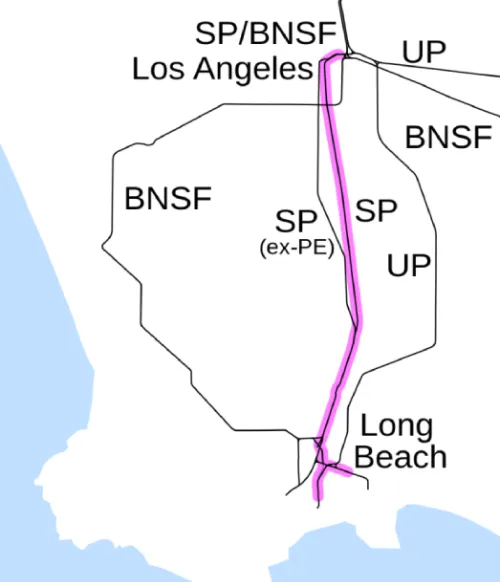The Ports of Los Angeles and Long Beach are both recognized as a gateway to the United States. To facilitate smooth trade, mitigate traffic congestion, and promote clean air initiatives the Alameda Corridor was established to connect both ports to Downtown Los Angeles, through a special railway system.
An Alameda Corridor Surcharge (ACS) is charged for moving containers from the Port of Los Angeles and Port of Long Beach to Downtown Los Angeles via rail transport. This surcharge is a pass-through fee and charged by the terminal operator to the cargo owner.
The Alameda Corridor Transportation Authority (ACTA) is in charge of managing this express railway line and its purpose is to ensure operability and pay for the maintenance and construction of the Alameda Corridor railway network.
This article will take an in-depth look at the Alameda Corridor Surcharge, how much it costs, how it’s calculated, how it came about and what the benefits are of moving cargo through the Alameda Corridor.
How Much is the Alameda Corridor Surcharge?
The Alameda Corridor Surcharge applies to all types of containers. This is a pass-on cost by ACTA to the carriers/terminal operators and eventually shouldered by the cargo owner. The current Alameda Corridor Surcharge rates in 2021 are as follows:
- 20’ Container: USD 27.00
- 40’ Container: USD 53.00
- 45’ Container: USD 60.00
Considering all the benefits of the Alameda Corridor and the on-going maintenance and project improvements that are being made to the railway, this surcharge cannot be negotiated or waived.
How to Calculate the Alameda Corridor Surcharge
The ACS calculation is straightforward and easy to understand. For example, an urgent shipment consisting of 3 x 20’ and 2 x 40’ containers need to be transported from the Port of Long Beach to Downtown Los Angeles via rail through the Alameda Corridor.
Based on the rates above, the calculation would be 3 x $27.00 and 2 x $53.00, amounting to a total of $187.00.
How did the Alameda Corridor Surcharge Come About?
The total project cost of the entire 20-mile high-capacity rail network through the Alameda Corridor amounted to USD 2.4 billion. The major reasons for approving this project was for the optimization of railways, as well as the additional reduction of road traffic for containers moving between the two ports and Downtown Los Angeles.

At the time this project was conceptualized movements through the Alameda Corridor were forecasted to be about 12.7 million containers a year. This was a huge increase compared to the 3.5 million containers that are moved via existing rail tracks.
Added benefits would also be less carbon emissions, reduced road traffic, faster connections and an expanded rail network.
Considering these benefits, the Alameda Corridor Transportation Authority opted to improve the drainage systems and constructed the railway along the highway, allowing for trains to transport containers stacked two high.
The user fee (which is called the Alameda Corridor Surcharge) was designed to recover the costs for the construction and on-going maintenance of the rail network..
What Are the Benefits of Using the Alameda Corridor?
There are several advantages that cargo owners can benefit from by moving containers via the rail network through the Alameda Corridor, as compared to using road trucks.
- Cutting transit time between the ports and the inland rail yards (Downtown Los Angeles), thus increasing efficiency without having trucks to transport containers individually.
- 30 trains travel the Alameda corridor a day accommodating up to 300 containers per trip. This allows cargo owners to move batches or containers in one go.
- Reduction of traffic congestion and pollution that is otherwise caused by trucks. This results in less carbon emissions and also lowers transit time between the port and the inland depots.
Are Alameda Corridor Surcharges also Applicable for Other Modes of Transport?
The Alameda Corridor Surcharges are only applicable for containers that are moved from the Port of Los Angeles and Port of Long Beach via rail connection through the Alameda Corridor.
This charge is not applicable for containers that are moved along the corridor via truck or through other rail routes.

Get Free Course Access
If you enjoyed the article, don’t miss out on our free supply chain courses that help you stay ahead in your industry.

Gerrit Poel
Co-Founder & Writer
at freightcourse
About the Author
Gerrit is a certified international supply chain management professional with 16 years of industry experience, having worked for one of the largest global freight forwarders.
As the co-founder of freightcourse, he’s committed to his passion for serving as a source of education and information on various supply chain topics.
Follow us